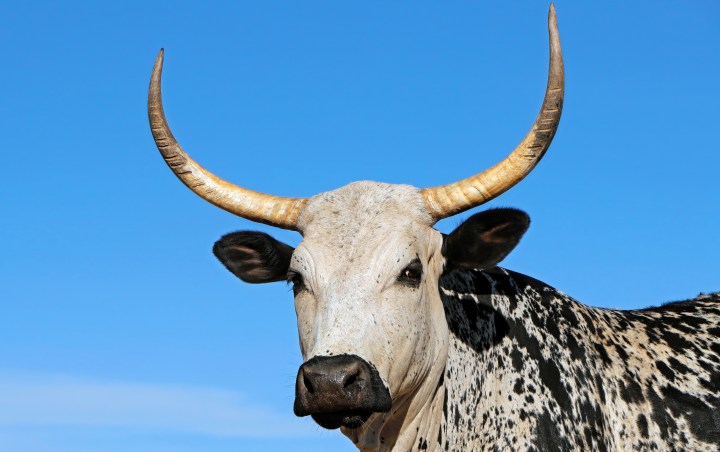REFLECTION
Bulls, beads, Boers and barter – were precolonial Xhosas’ Nguni cattle the original NFTs?

Long, long ago, precolonial communities knew all about beads, cattle and non-fungible tokens.
When diamond-dealer-with-bank-accounts-frozen-by-the-cops Louis Liebenberg deposited two Nguni cattle in the green fields of former president Jacob Zuma’s Nkandla headquarters in 2022 he may have been hoping for a good return on his investment.
Lolsies.
But long before the pale people with the see-through ears and weird outfits washed up with the foam on the beaches of the Eastern Cape around 1820, an economy had already been functioning in the region and beyond for yonks.
While Zuma and Liebenberg might be going back to the basics of trade and barter, considering their track records, managing not only their own money but everyone else’s, it is unlikely that either understands the principles of fair exchange and decent profit.
But long before White Monopoly Capital (Liebenberg has been exempted from this mysterious grouping by daddy’s darling, Dudu Zuma-Sambudla, who says at least Liebenberg is helping a black man), the kingdoms of Africa had their own stock exchanges, literally and in the form of non-fungible tokens (NFTs).
First published in 1981, historian Jeff Peires’s brilliant The House of Phalo (Jonathan Ball) is an invaluable resource when it comes to life, trade and the economy in independent Xhosa kingdoms, of which there were many.
This trade – which reached as far as North West – goes all the way back to the 17th century. But you won’t learn about it in the school curriculum.
Do the maths
Peires notes in his chapter on precolonial exchanges and innovations that while trading cattle for beads or copper was exchanging one form of currency for another, it was in fact a form of financial speculation.
“Individual transactions are comprehensible only as part of a series. A would sell cattle to B in exchange for beads and then make a profit by selling the beads to C for more cattle than the beads had originally cost him,” writes the historian.
C was perfectly entitled to attempt to make a profit by selling the beads to D for more cattle than he paid A.
As a result, a string of beads could move from Delagoa Bay to “Xhosaland” or the precolonial Eastern Cape to Natal and even further.
“Theoretically there should be no losers in such a series of transactions as the value of the beads depended not on their intrinsic value, but on their value in terms of cattle which, in turn, depended on their rarity.”
Read in Daily Maverick: “Out with the tick-boxers, in with the anarchists – be like Chairman Atchar and break the rules”
Of course, the danger with this type of speculation at the time was that a glut in supply would cause the exchange value of one trade item to fall relative to others.
A while ago, during a parliamentary Standing Committee on Public Accounts hearing into the shameful mess Bathabile Dlamini made of the South African Social Security Agency grant payments, an MP described the department’s deal with the US-based Cash Paymaster Services as “the same as the colonists coming here and offering us beads. You sold the country.” The member displays a commonly held and erroneous view that indigenous peoples could be “beguiled” by shiny objects, which to the Western traders had no value.
Origin of NFTs
Okay, not long after the beads and cattle and copper stock exchange was disrupted by the arrival of the trekboers fleeing the British and the arrival of the imperial British themselves in the Eastern Cape, it was the postage stamp that could be viewed as an NFT.
Of course, nowhere will you read that before stamps, which are regarded as the first NFTs, there were beads and cattle.
While the British Empire at its peak in 1922 covered a quarter of the Earth’s land surface and lorded it over 458 million people, the postal system in that country had “stagnated”.
Post was free for the rich, while the rest had to pay on receipt of the item. There was no set price.
Author Nick Redfeather, writing for CoinsPaid Media, explained how a postal clerk, Sarah Lee, had to return an item if the courier overcharged, while the rich got off scot-free. It was her son, Rowland, who in 1837 came up with the idea of “mould-proofing” payment on envelopes – the stamp.
“A critical moment for our history occurred on [6 May 1840], when the law firm of Oliverson, Denby & Levy picked up the idea of printed stamps and sent an envelope to Scotland that had [10] black stamps with a picture of Queen Victoria and the inscription One Penny. They were called the Black Penny. It was the first ever sent prepaid letter.”
People soon realised that each stamp was different and began collecting them.
Not all stamps were valuable or collectable, like cows, and each came with an interesting mark or unique feature.
“Thus, an envelope from the first ever prepaid letter was sold for 690 thousand francs at an auction in Zurich in 1992,” writes Redfeather.
“The Xhosa economy was neither static nor subsistence oriented. That there was no lack of innovation is demonstrated by the introduction of new crops such as maize (18th century), production for the market, and trade with other peoples,” writes Peires.
Read in Daily Maverick: “The Lie of 1652: A decolonised history of land”
For the Xhosa traders beads were a source of profit “and at least one Boer was turned back”, writes Peires, with the admonishment about their crap stock described as “the want of articles suited to barter”.
NFT lobola?
In the world as we know it now, stamps that we used to lick and stick on envelopes have gone “crypto”.
Could it be only a matter of time before gorgeous Nguni cows finally come full circle as the world’s first NFTs, born here in Africa? DM168
Marianne Thamm is the assistant editor of Daily Maverick.
This story first appeared in our weekly Daily Maverick 168 newspaper, which is available countrywide for R25.




















The trade continues. I buy copper, the locals remove it. Still waiting for the cattle though…